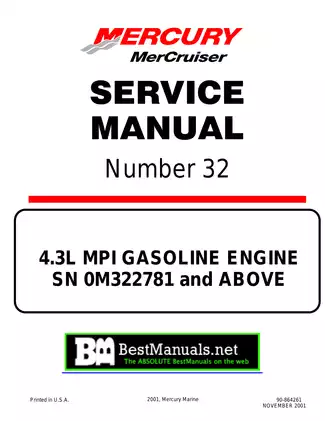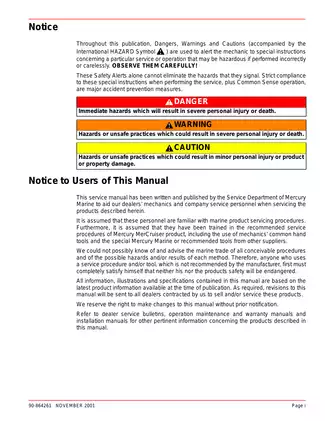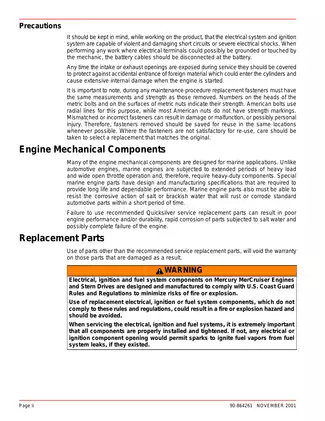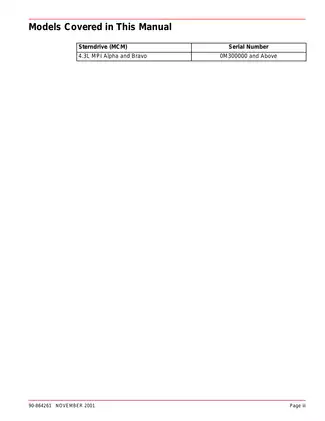Mercury MerCruiser 4.3L MPI Service Manual - Comprehensive Guide for Marine Mechanics
Product Gallery

Sample pages from the Mercury MerCruiser 4.3L MPI Service Manual - Comprehensive Guide for Marine Mechanics manual




Purchase Information
Mercury MerCruiser 4.3L MPI Service Manual - Comprehensive Guide for Marine Mechanics - Technical Specifications
- File Size:
- 21.43 MB
- File Type:
- Language:
- English
- Pages:
- 500+
- Printable:
- Yes
- Estimated Download Time:
- 0.44 Minutes
- Delivery Format:
- Digital (PDF) - Instant Access
- Category:
- Outboard
- Brand:
- Mercury
Mercury Models and Parts Covered in this Outboard Manual
- Mercury MerCruiser 4.3L MPI (2001)
Mercury Mercury MerCruiser 4.3L MPI Service Manual - Comprehensive Guide for Marine Mechanics - Complete Manual Information
Mercury MerCruiser 4.3L MPI Service Manual
The Mercury MerCruiser 4.3L MPI Service Manual is an indispensable resource for marine mechanics and enthusiasts alike. This comprehensive manual, updated as of November 2001, presents detailed specifications, service procedures, and maintenance guidelines specifically for the 4.3L MPI gasoline engine. With this manual, you will gain a deeper understanding of the engine's design and operation, allowing efficient servicing and repairs.
Features of the Manual
- Identification: Easy identification of Mercury MerCruiser model codes and specifications.
- General Specifications: Exhaustive information on engine components, performance specs, and requirements.
- Torque Specifications: Detailed torque values for various engine components to ensure proper assembly and maintenance.
- Camshaft and Piston Assembly Details: In-depth instructions on the removal, cleaning, inspection, and reassembly of crucial engine parts.
- Troubleshooting: Clear guidance on diagnosing common issues, measures to fix them, and detection of parts that need replacement.
What's Inside
- Chapter 1: General Information
- Chapter 2: Maintenance Procedures
- Detailed torque specifications for every component.
- List of special tools and recommended lubricants.
- Chapter 3: Engine Mechanical
- Specifications for pistons, cylinders, and crankshafts.
- Instructions for valve examinations, camshaft adjustments, and more.
Each section is structured to aid in effective navigation, allowing technicians to easily locate essential information needed to maintain or repair the 4.3L MPI engine. The manual emphasizes safety alerts and common service procedures, providing an expert companion in the workshop or at the dock
Download Instructions for Mercury Outboard Manual
Frequently Asked Questions - Mercury Outboard Manual
What does this Mercury manual cover?
This comprehensive service manual covers detailed repair procedures, maintenance schedules, troubleshooting guides, and technical specifications for Mercury MerCruiser 4.3L MPI Service Manual - Comprehensive Guide for Marine Mechanics. It includes information for the following models: - Mercury MerCruiser 4.3L MPI (2001).
Is this manual suitable for beginners?
Yes, this Mercury manual is designed for both professional technicians and DIY enthusiasts. It includes step-by-step procedures with clear illustrations and safety guidelines for Outboard maintenance and repair.
What file format will I receive?
You will receive this manual as a PDF file (21.43 MB), which is compatible with all devices. The manual is fully searchable and printable for your convenience.
How quickly can I access the manual after purchase?
You'll receive instant access to your Mercury Outboard manual immediately after payment completion. The download link is valid for 3 days, with lifetime re-download guarantee.
Can I print specific sections of the manual?
Absolutely! This digital manual allows you to print any section you need, from individual pages to complete chapters, making it perfect for workshop use.
Mercury Mercury MerCruiser 4.3L MPI Service Manual - Comprehensive Guide for Marine Mechanics Customer Reviews and Feedback
Read what our customers say about this Mercury Outboard manual and share your own experience.
Add Comment
This policy contains information about your privacy. By posting, you are declaring that you understand this policy:
- Your name, rating, website address, town, country, state and comment will be publicly displayed if entered.
- Aside from the data entered into these form fields, other stored data about your comment will include:
- Your IP address (not displayed)
- The time/date of your submission (displayed)
- Your email address will not be shared. It is collected for only two reasons:
- Administrative purposes, should a need to contact you arise.
- To inform you of new comments, should you subscribe to receive notifications.
- A cookie may be set on your computer. This is used to remember your inputs. It will expire by itself.
This policy is subject to change at any time and without notice.
These terms and conditions contain rules about posting comments. By submitting a comment, you are declaring that you agree with these rules:
- Although the administrator will attempt to moderate comments, it is impossible for every comment to have been moderated at any given time.
- You acknowledge that all comments express the views and opinions of the original author and not those of the administrator.
- You agree not to post any material which is knowingly false, obscene, hateful, threatening, harassing or invasive of a person's privacy.
- The administrator has the right to edit, move or remove any comment for any reason and without notice.
Failure to comply with these rules may result in being banned from submitting further comments.
These terms and conditions are subject to change at any time and without notice.
Comments (5)